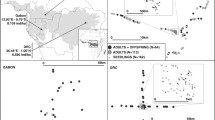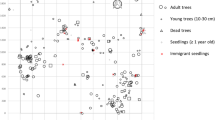Abstract
The effects of population density on male and female reproductive success of Betula maximowicziana were evaluated in two mixed and two post-fire stands, with various population densities, ranging from 1.9 to 300.0 trees per ha, in central Hokkaido, Japan. First, we investigated ecological determinants of reproductive success (seed set and germination) of both seeds collected from the trees (tree seeds) and dispersed seeds collected from seed traps (dispersed seeds). We then evaluated the effects of population density on seed set and germination of tree seeds and dispersed seeds using a generalized linear mixed model (GLMM). Subsequently, we genotyped 950 seeds collected from mother trees and 940 seeds trapped after dispersal derived from tree seeds and dispersed seeds, respectively, using eleven microsatellite loci. Using the acquired data, we then evaluated the outcrossing rate and effective number of pollen donors (N ep) of the tree seeds, and the genetic structure of both pollen pools and dispersed seed populations. The seed set and germination rate of dispersed seeds was significantly lower both in the lowest-density stand and in the highest-density stand. The GLMM revealed that seed set and germination rates of dispersed seeds may be maximal at approximately 120 trees per hectare (optimal density). Outcrossing rates were consistently high (t m = 0.995), regardless of the population density. In contrast, N ep was lower in the lowest-density stands. Significant genetic structure of the dispersed seed population was found in two low-density stands, probably due to the limitation of overlapping seed shadows.





Similar content being viewed by others
References
Aldrich PR, Hamrick JL (1998) Reproductive dominance of pasture trees in a fragmented tropical forest mosaic. Science 281:103–105. doi:10.1126/science.281.5373.103
Bacles CFE, Burczyk J, Lowe AJ et al (2005) Historical and contemporary mating patterns in remnant populations of the forest tree Fraxinus excelsior L. Evolution 59:979–990
Campbell DR, Halama KJ (1993) Resource and pollen limitations to lifetime seed production in a natural plant population. Ecology 74:1043–1051. doi:10.2307/1940474
Chung MY, Nason J, Chung MG et al (2002) Landscape-level spatial genetic structure in Quercus acutissima (Fagaceae). Am J Bot 89:1229–1236. doi:10.3732/ajb.89.8.1229
Doligez A, Joly HI (1997) Genetic diversity and spatial structure within a natural stand of a tropical forest tree species, Carapa procera (Meliaceae), in French Guiana. Heredity 79:72–82. doi:10.1038/hdy.1997.124
Dyer RJ, Sork VL (2001) Pollen pool heterogeneity in shortleaf pine, Pinus echinata Mill. Mol Ecol 10:859–866. doi:10.1046/j.1365-294X.2001.01251.x
Fuchs EJ, Lobo JA, Quesada M (2003) Effects of forest fragmentation and flowering phenology on the reproductive success and mating patterns of the tropical dry forest tree Pachira quinata. Conserv Biol 17:149–157. doi:10.1046/j.1523-1739.2003.01140.x
Godoy JA, Jordano P (2001) Seed dispersal by animals: exact identification of source trees with endocarp DNA microsatellites. Mol Ecol 10:2275–2283. doi:10.1046/j.0962-1083.2001.01342.x
Goto S, Tsuda Y, Nagafuji K et al (2004) Genetic make-up and diversity of regenerated Betula maximowicziana Regel. sapling populations in scarified patches as revealed by microsatellite analysis. Forest Ecol Manage 203:273–282
Goto S, Shimatani K, Yoshimaru H et al (2006) Fat-tailed gene flow in the dioecious canopy tree species Fraxinus mandshurica var japonica revealed by microsatellites. Mol Ecol 15:2985–2996
Hagman M (1975) Incompatibility in forest trees. Proc R Soc Lond B Biol Sci 188:313–326. doi:10.1098/rspb.1975.0022
Haig D, Westoby M (1988) On limits to seed production. Am Nat 131:757–759. doi:10.1086/284817
Hamrick JL, Murawski DA, Nason JD (1993) The influence of seed dispersal mechanisms on the genetic structure of tropical tree populations. Vegetatio 108:281–297
Itahana N, Koono K, Nagasaka K et al (1997) Seed fertility in intra- and inter specific crossing in Betula. Trans Meet Hokkaido Br J Jap For Soc 45:25–27 (in Japanese)
Kalisz S, Nason JD, Hanzawa FM et al (2001) Spatial population genetic structure in Trillium grandiflorum: the roles of dispersal, mating, history, and selection. Evolution 55:1560–1568
Knapp EE, Goedde MA, Rice KJ (2001) Pollen-limited reproduction in blue oak: implications for wind pollination in fragmented populations. Oecologia 128:48–55. doi:10.1007/s004420000623
Knight TM, Steets JA, Vamosi JC et al (2005) Pollen limitation of plant reproduction: pattern and process. Annu Rev Ecol Evol Syst 36:467–497. doi:10.1146/annurev.ecolsys.36.102403.115320
Kramer AT, Ison JL, Ashley MV et al (2008) The paradox of forest fragmentation genetics. Conserv Biol 22(4):878–885
Lee SL (2000) Mating system parameters of Dryobalanops aromatica Gaertn. f. (Dipterocarpaceae) in three different forest types and a seed orchard. Heredity 85:338–345. doi:10.1046/j.1365-2540.2000.00761.x
Lian CL, Miwa M, Hogetsu T (2001) Outcrossing and paternity analysis of Pinus densiflora (Japanese red pine) by microsatellite polymorphism. Heredity 87:88–98. doi:10.1046/j.1365-2540.2001.00913.x
Loiselle BA, Sork VL, Nason J et al (1995) Spatial genetic structure of a tropical understory shrub, Psychotria officinalis (Rubiaceae). Am J Bot 82:1420–1425. doi:10.2307/2445869
Lowe AJ, Boshier D, Ward M et al (2005) Genetic resource impacts of habitat loss and degradation; reconciling empirical evidence and predicted theory for neotropical trees. Heredity 95:255–273. doi:10.1038/sj.hdy.6800725
Mantel N (1967) The detection of disease clustering and a generalized regression approach. Cancer Res 27:209–220
Nakanishi A, Tomaru N, Yoshimaru H et al (2004) Patterns of pollen flow and genetic differentiation among pollen pools in Quercus salicina in a warm temperate old-growth evergreen broad-leaved forest. Silvae Genet 53:258–264
Nason JD, Hamrick JL (1997) Reproductive and genetic consequences of forest fragmentation: Two case studies of neotropical canopy trees. J Hered 88:264–276
O’Connell LM, Mosseler A, Rajora OP (2006a) Impacts of forest fragmentation on the mating system and genetic diversity of white spruce (Picea glauca) at the landscape level. Heredity 97:418–426. doi:10.1038/sj.hdy.6800886
O’Connell LM, Mosseler A, Rajora OP (2006b) Impacts of forest fragmentation on the reproductive success of white spruce (Picea glauca). Can J Bot 84:956–965. doi:10.1139/B06-051
Obayashi K, Tsumura Y, Ihara-Ujino T et al (2002) Genetic diversity and outcrossing rate between undisturbed and selectively logged forests of Shorea curtisii (Dipterocarpaceae) using microsatellite DNA analysis. Int J Plant Sci 163:151–158. doi:10.1086/324549
Ogyu K, Tsuda Y, Sugaya T et al (2003) Identification and characterization of microsatellite loci in Betula maximowicziana Regel. Mol Ecol Notes 3:268–269. doi:10.1046/j.1471-8286.2003.00419.x
Peakall R, Beattie AJ (1995) Does ant dispersal of seeds in Sclerolaena Diacantha (Chenopodiaceae) generate local spatial genetic-structure. Heredity 75:351–361. doi:10.1038/hdy.1995.146
Peakall R, Smouse PE (2006) GENALEX 6: genetic analysis in ExcelPopulation genetic software for teaching and research. Mol Ecol Notes 6:288–295. doi:10.1111/j.1471-8286.2005.01155.x
R Development Core Team (2006) R: a language and environment for statistical computing, R Foundation for Statistical Computing, Vienna, Austria. www.R-project.org
Ritland K (2002) Extensions of models for the estimation of mating systems using n independent loci. Heredity 88:221–228. doi:10.1038/sj.hdy.6800029
Robledo-Arnuncio JJ, Alía R, Gil L (2004a) Increased selfing and correlated paternity in a small population of a predominantly outcrossing conifer, Pinus sylvestris. Mol Ecol 13:2567–2577. doi:10.1111/j.1365-294X.2004.02251.x
Robledo-Arnuncio JJ, Smouse PE, Gil L et al (2004b) Pollen movement under alternative silvicultural practices in native populations of Scots pine (Pinus sylvestris L.) in central Spain. For Ecol Manage 197:245–255. doi:10.1016/j.foreco.2004.05.016
Rousset F (1997) Genetic differentiation and estimation of gene flow from F-statistics under isolation by distance. Genetics 145:1219–1228
Sato T, Isagi Y, Sakio H et al (2006) Effect of gene flow on spatial genetic structure in the riparian canopy tree Cercidiphyllum japonicum revealed by microsatellite analysis. Heredity 96:79–84
Schnabel A, Nason JD, Hamrick JL (1998) Understanding the population genetic structure of Gleditsia triacanthos L.: seed dispersal and variation in female reproductive success. Mol Ecol 7:819–832. doi:10.1046/j.1365-294x.1998.00397.x
Schuster WSF, Mitton JB (2000) Paternity and gene dispersal in limber pine (Pinus flexilis James). Heredity 84:348–361. doi:10.1046/j.1365-2540.2000.00684.x
Seavey SR, Bawa KS (1986) Late-acting self-incompatibility in angiosperms. Bot Rev 52:195–219. doi:10.1007/BF02861001
Sezen UU, Chazdon RL, Holsinger KE (2005) Genetic consequences of tropical second-growth forest regeneration. Science 307:891–891. doi:10.1126/science.1105034
Smouse PE, Dyer RJ, Westfall RD et al (2001) Two-generation analysis of pollen flow across a landscape I. Male gamete heterogeneity among females. Evolution 55:260–271
Sork VL, Smouse PE (2006) Genetic analysis of landscape connectivity in tree populations. Landscape Ecol 21:821–836. doi:10.1007/s10980-005-5415-9
Sork VL, Davis FW, Smouse PE et al (2002) Pollen movement in declining populations of California Valley oak, Quercus lobata: where have all the fathers gone? Mol Ecol 11:1657–1668. doi:10.1046/j.1365-294X.2002.01574.x
Stacy EA, Hamrick JL, Nason JD et al (1996) Pollen dispersal in low-density populations of three neotropical tree species. Am Nat 148:275–298. doi:10.1086/285925
Tomita M, Saito H, Suyama Y (2008) Effect of local stand density on reproductive processes of the sub-boreal conifer Picea jezoensis Carr. (Pinaceae). For Ecol Manage. doi:10.1016/j.foreco.2008.06.037
Tsuda Y, Ide Y (2005) Wide-range analysis of genetic structure of Betula maximowicziana, a long-lived pioneer tree species and noble hardwood in the cool temperate zone of Japan. Mol Ecol 14:3929–3941
Tsuda S, Goto S, Takahashi Y et al (2002) Vegetation of an eighty seven-year-old stand after a forest fire in mixed conifer-hardwood forest, central Hokkaido, Japan. Veg Sci 19:125–130. in Japanese
Uchiyama K, Goto S, Tsuda Y et al (2006) Genetic diversity and genetic structure of adult and buried seed populations of Betula maximowicziana in mixed and post-fire stands. For Ecol Manage 237:119–126. doi:10.1016/j.foreco.2006.09.037
Willson MF, Burley N (1983) Mate choice in plants. Princeton University Press, Princeton New Jersey, USA
Wright S (1943) Isolation by distance. Genetics 28:114–138
Wu B, Lian C, Hogetsu T (2002) Development of microsatellite markers in white birch (Betula platyphylla var. japonica). Mol Ecol Notes 2:413–415. doi:10.1046/j.1471-8286.2002.00260.x
Young A, Boyle T, Brown T (1996) The population genetic consequences of habitat fragmentation for plants. Trends Ecol Evol 11:413–418. doi:10.1016/0169-5347(96)10045-8
Acknowledgements
We appreciate the contribution of Y. Takahashi and staff of the Tokyo University Forest in Hokkaido. We are also grateful to Dr. Y. Tsuda of the Forestry and Forest Products Research Institute, and Y. Saito of the Laboratory of Forest Ecosystem Studies, Department of Ecosystem Studies, Graduate School of Agricultural and Life Sciences, the University of Tokyo for helpful comments. A part of this study was supported by a Grant-in-Aid for Scientific Research (No. 19380082) from the Ministry of Education, Culture, Sports, Science and Technology of Japan.
Author information
Authors and Affiliations
Corresponding author
Rights and permissions
About this article
Cite this article
Uchiyama, K., Goto, S. & Ide, Y. Effects of population density on male and female reproductive success in the wind-pollinated, wind-dispersed tree species Betula maximowicziana . Conserv Genet 10, 1265–1275 (2009). https://doi.org/10.1007/s10592-008-9694-y
Received:
Accepted:
Published:
Issue Date:
DOI: https://doi.org/10.1007/s10592-008-9694-y




